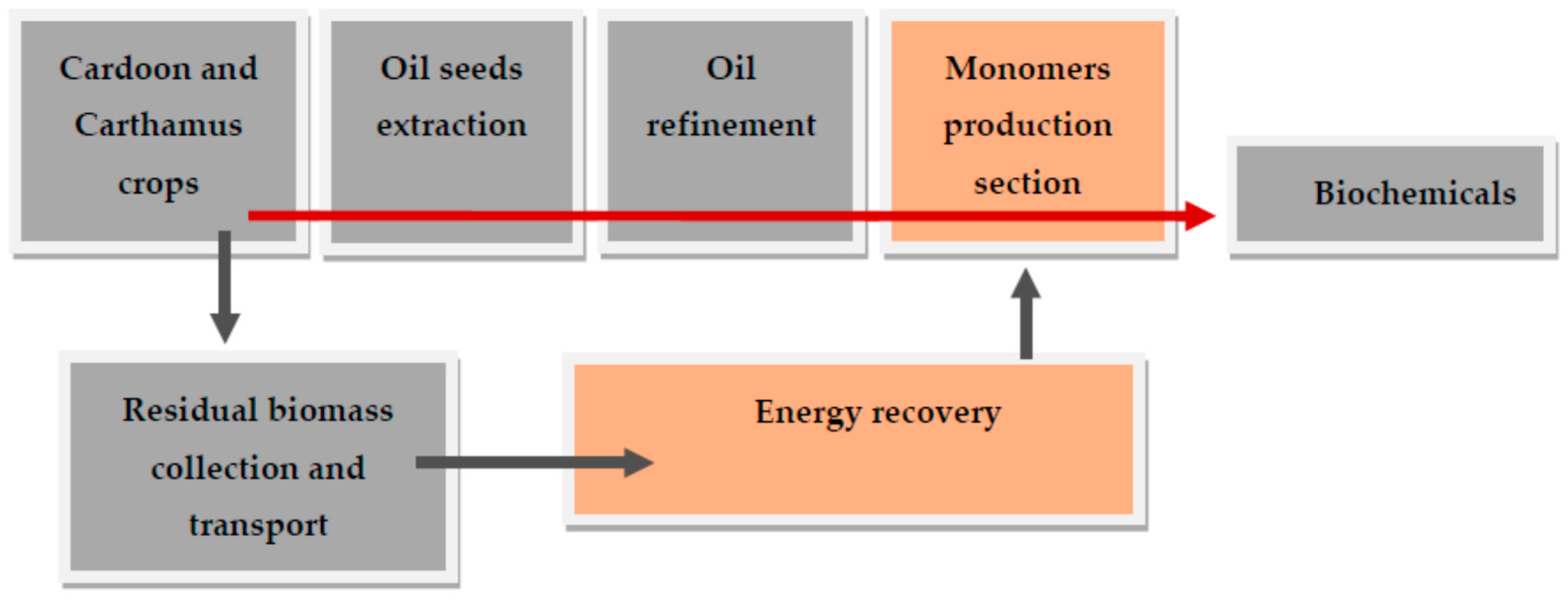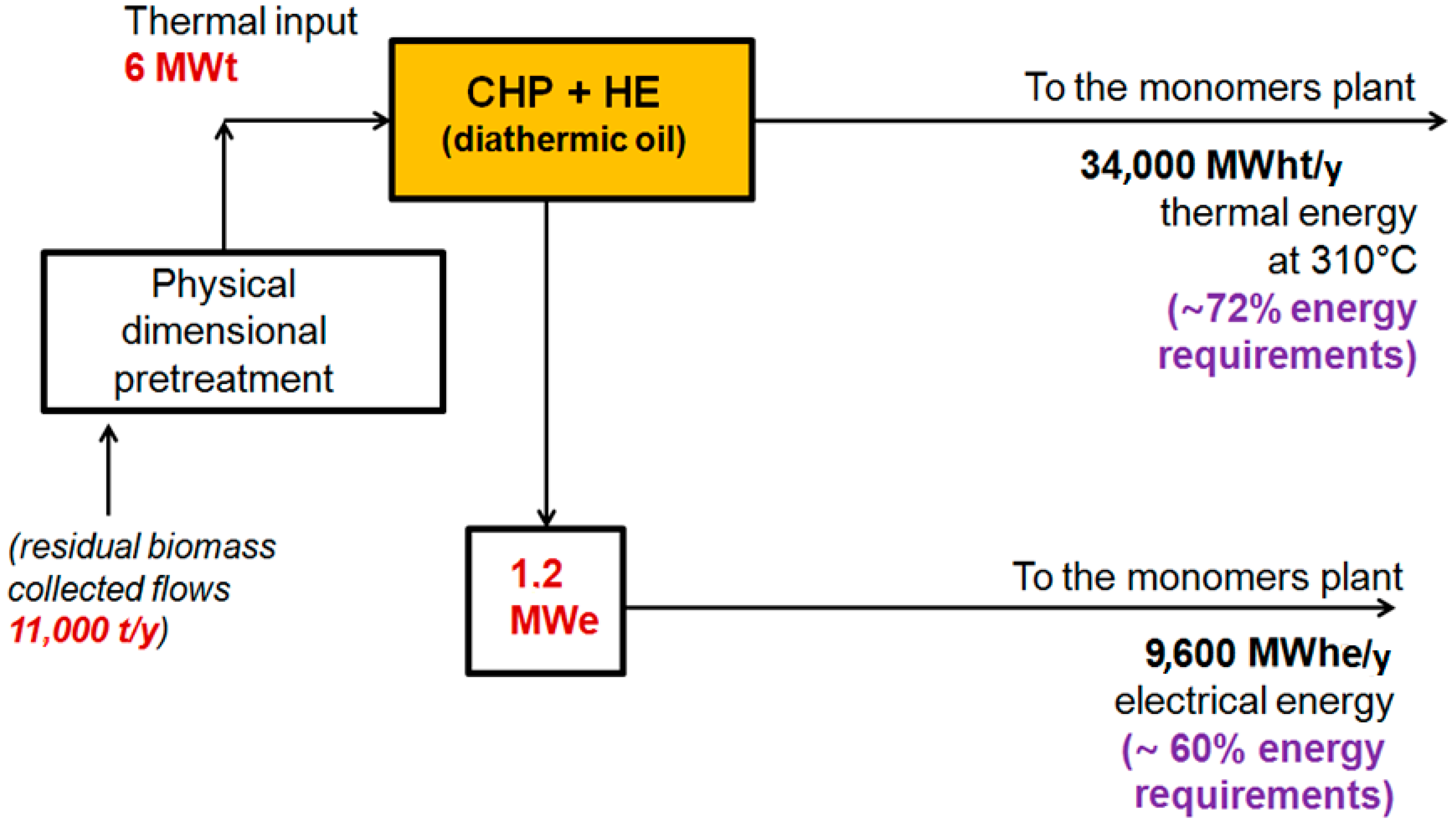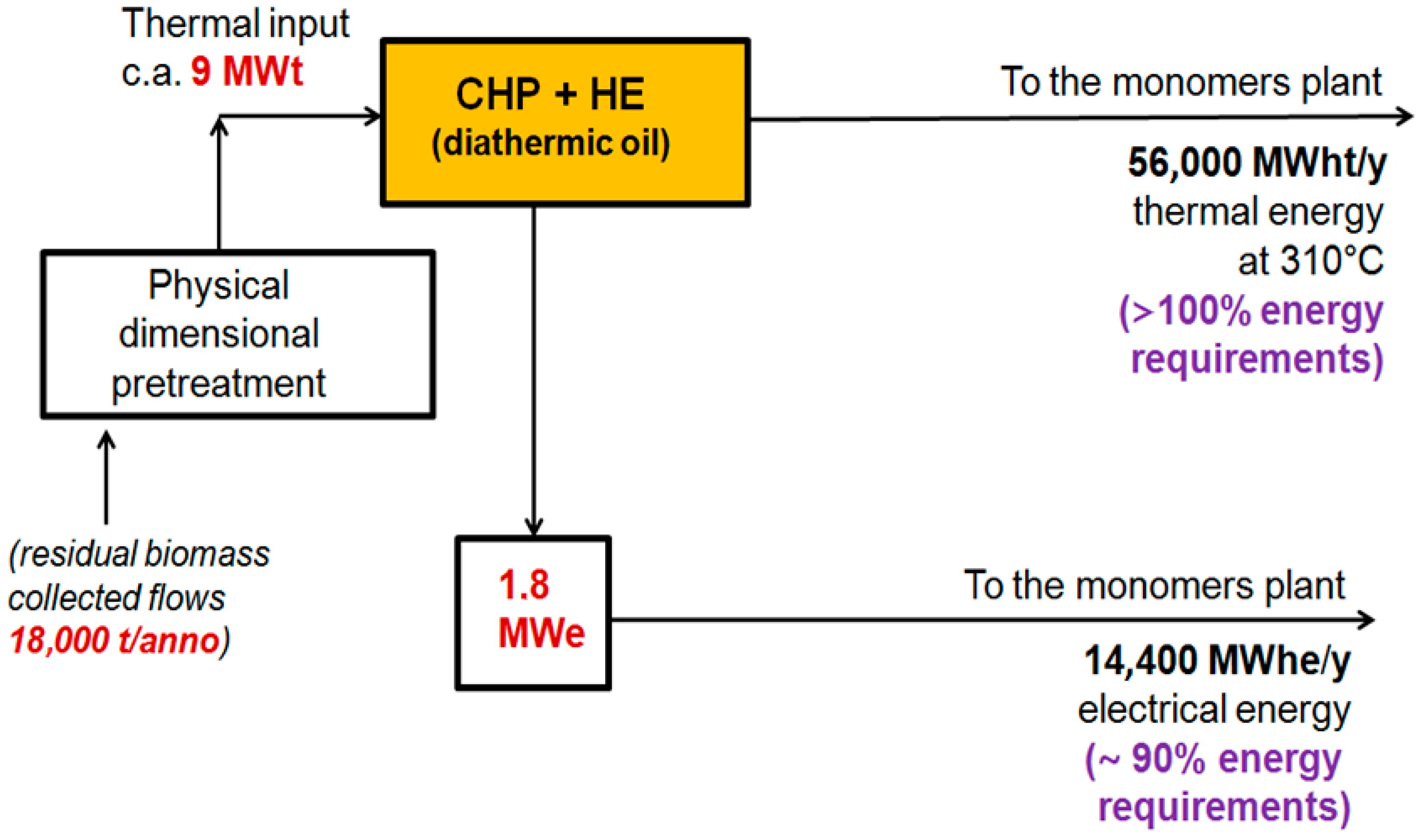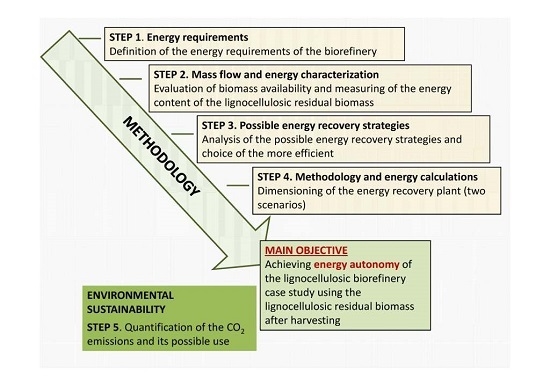Energy Opportunities from Lignocellulosic Biomass for a Biorefinery Case Study
Abstract
:1. Introduction
2. Energy Requirements
3. Mass Flow and Energy Characterization
4. Possible Energy Recovery Strategies
- (1)
- anaerobic digestion technology;
- (2)
- gasification technology;
- (3)
- a cogeneration system (CHP-Combined Heat and Power) working at high temperature.
5. Methodology and Energy Calculations
- TICHP is the thermal input to the CHP plant in MWt;
- EC is the energy content of the residual biomass in kWht/kg;
- CB is the annual flow of the collected residual biomass to be used as the input to the plant in tons/year;
- H is the number of the annual functioning hours for the CHP plant in hours/year.
- the investment costs for the installation of a 6–9 MWt and a 1.3–1.8 MWe CHP plants vary between 4.0 and 6.0 M€ [33];
- the operating costs can be estimated annually as about 5% of the investment costs;
- the costs for the biomass is only related to the logistical and transportation costs, and it depends on the biomass availability distribution;
- the revenues for the plants should be evaluated accordingly with the incentive system after subtracting the net thermal and electrical energy requirements.
6. Quantification of the CO2 Emissions and Its Possible Use
7. Conclusions
Acknowledgments
Author Contributions
Conflicts of Interest
Abbreviations
| BIT3G project | Italian acronym for “Third generation biorefinery spread in the territory” |
| CRB/CIRIAF | CRB is the acronym for National Biomass Research Center. CRB is a section of the CIRIAF that is the Interuniversity Research Center of Pollution and Environment “M. Felli” of the University of Perugia |
References
- Kurian, J.K.; Nair, G.R.; Hussain, A.; Vijaya Raghavan, G.S. Feedstocks, logistics and pre-treatment processes for sustainable lignocellulosic biorefineries: A comprehensive review. Renew. Sustain. Energy Rev. 2013, 25, 205–219. [Google Scholar] [CrossRef]
- Menon, V.; Rao, M. Trends in bioconversion of lignocellulose: Biofuels, platform chemicals & biorefinery concept. Prog. Energy Combust. Sci. 2012, 38, 522–550. [Google Scholar]
- O’Keeffe, S.; Schulte, R.P.O.; Sanders, J.P.M.; Struik, I. Technical assessment for first generation green biorefinery (GBR) using mass and energy balances: Scenarios for an Irish GBR blueprint. Biomass Bioenergy 2011, 35, 4712–4723. [Google Scholar] [CrossRef]
- Kim, S.; Dale, B.E. Comparing alternative cellulosic biomass biorefining systems: Centralized versus distributed processing systems. Biomass Bioenergy 2015, 74, 135–147. [Google Scholar] [CrossRef]
- Yılmaz, S.; Selim, H. A review on the methods for biomass to energy conversion systems design. Renew. Sustain. Energy Rev. 2013, 25, 420–430. [Google Scholar] [CrossRef]
- World Economic Forum Report on The future of Biorefineries. Available online: https://www.rairarubiabooks.com/related-pdf-world-economic-forum-report-on-the-future-of-biorefineries.html (accessed on 18 July 2016).
- Godard, A.; de Caro, P.; Thiebaud-Roux, S.; Vedrenne, E.; Mouloungui, Z. New Environmentally Friendly Oxidative Scission of Oleic Acid into Azelaic Acid and Pelargonic Acid. J. Am. Oil Chem. Soc. 2013, 90, 133–140. [Google Scholar] [CrossRef]
- Li, Q.; Hu, G. Techno-economic analysis of biofuel production considering logistic configurtations. Bioresour. Technol. 2016, 206, 195–203. [Google Scholar] [CrossRef] [PubMed]
- Cambero, C.; Sowlati, T. Incorporating social benefits in multi-objective optimization of forest-based bioenergy and biofuel supply chain. Appl. Energy 2016, 178, 721–735. [Google Scholar] [CrossRef]
- Salvachùa, D.; Smith, H.; St. John, P.C.; Mohagheghi, A.; Peterson, D.J.; Black, B.A.; Dowe, N.; Beckham, G.T. Succinic acid production from lignocellulosic hydrosilate by Basfia succiniproducens. Bioresour. Technol. 2016, 214, 558–566. [Google Scholar]
- AI Loman, A.; Ju, L.K. Soybean carbohydrate as fermentation feedstock for production of biofuels and value-added chemicals. Process Biochem. 2016, 51, 1046–1057. [Google Scholar] [CrossRef]
- Baral, N.R.; Wituszynski, D.M.; Martin, J.F.; Shah, A. Sustainability assessment of cellulosic biorefinery stillage utilization methods using emergy analysis. Energy 2016, 109, 13–28. [Google Scholar] [CrossRef]
- Cotana, F.; Cavalaglio, G.; Gelosia, M.; Coccia, V.; Petrozzi, A.; Ingles, D.; Pompili, E. A comparison between SHF and SSSF processes from cardoon for ethanol production. Ind. Crops Prod. 2015, 69, 424–432. [Google Scholar] [CrossRef]
- Cotana, F.; Cavalaglio, G.; Gelosia, M.; Coccia, V.; Petrozzi, A.; Nicolini, A. Effect of double-step steam explosion pretreatment in bioethanol production from softwood. Appl. Biochem. Biotechnol. 2014, 174, 156–167. [Google Scholar] [CrossRef] [PubMed]
- Costa, C.B.B.; Potrich, E.; Cruz, A.J.G. Multiobjective optimization of sugarcane biorefinery involving process and environmental aspects. Renew. Energy 2016, 96, 1142–1152. [Google Scholar] [CrossRef]
- Barrera, I.; Amezcua-Allieri, M.A.; Estupinan, L.; Martinez, T.; Aburto, J. Technical and economical evaluation of bioethanol production from lignocellulosic residues in Mexico: Case of sugarcane and blue agave bagasses. Chem. Eng. Res. Des. 2016, 107, 91–101. [Google Scholar] [CrossRef]
- Fantozzi, F.; Barbanera, M.; Bartocci, P.; Massoli, S.; Buratti, C. Caratterizzazione delle biomasse Il laboratorio del CRB. La Termotecnica 2008, 6, 56–60. [Google Scholar]
- Kawaguchi, H.; Hasunuma, T.; Ogino, C.; Kondo, A. Bioprocessing of bio-based chemicals produced from lignocellulosic feedstocks. Curr. Opin. Biotechnol. 2016, 42, 30–39. [Google Scholar] [CrossRef] [PubMed]
- D’Avino, L.; Dainelli, R.; Lazzeri, L.; Spugnoli, P. The role of co-products in biorefinery sustainability: Energy allocation versus substitution method in rapeseed and carinata biodiesel chains. J. Clean. Prod. 2015, 94, 108–115. [Google Scholar] [CrossRef]
- Martína, M.; Grossmann, I.E. Systematic synthesis of sustainable biorefineries: A review. Ind. Eng. Chem. Res. 2013, 52, 3044–3064. [Google Scholar] [CrossRef]
- Demirbas, M.F. Biorefineries for biofuel upgrading: A critical review. Appl. Energy 2009, 86, 151–161. [Google Scholar] [CrossRef]
- Cherubini, F. The biorefinery concept: Using biomass instead of oil for producing energy and chemicals. Energy Convers. Manag. 2010, 51, 1412–1421. [Google Scholar] [CrossRef]
- Shatalov, A.A.; Pereira, H. Biorefinery of Energy Crop Cardoon (Cynara cardunculus I.)-Hydrolytic Xylose Production as Entry Point to Complex Fractionation Scheme. J. Chem. Eng. Process Technol. 2011. [Google Scholar] [CrossRef]
- Serrano-Ruiza, J.C.; Dumesic, J.A. Catalytic routes for the conversion of biomass into liquid hydrocarbon transportation fuels. Energy Environ. Sci. 2011, 4, 83–99. [Google Scholar] [CrossRef]
- Cotana, F.; Coccia, V.; Petrozzi, A.; Cavalaglio, G.; Gelosia, M.; Merico, M.C. Energy valorization of poultry manure in a thermal power plant: Experimental campaign. Energy Procedia 2013, 45, 315–322. [Google Scholar] [CrossRef]
- Cotana, F.; Messineo, A.; Petrozzi, A.; Coccia, V.; Cavalaglio, G.; Aquino, A. Comparison of ORC turbine and stirling engine to produce electricity from gasified poultry waste. Sustainability 2014, 6, 5714–5729. [Google Scholar] [CrossRef]
- Cotana, F.; Cavalaglio, G.; Petrozzi, A.; Coccia, V. Lignocellulosic biomass feeding in biogas pathway: State of the art and plant layouts. Energy Procedia 2015, 81, 1231–1237. [Google Scholar] [CrossRef]
- Liew, L.N.; Shi, J.; Li, Y. Methane production from solid-state anaerobic digestion of lignocellulosic biomass. Biomass Bioenergy 2012, 46, 125–132. [Google Scholar] [CrossRef]
- Kizha, A.R.; Han, H.S. Processing and sorting forest residues: Cost, productivity and managerial impacts. Biomass Bioenergy 2016, 93, 97–106. [Google Scholar] [CrossRef]
- Diaz, G.; Moreno, B. Valuation under uncertain energy prices and load demands of micro-CHP plants supplemented by optimally switched thermal energy storage. Appl. Energy 2016, 177, 553–569. [Google Scholar] [CrossRef]
- Patuzzi, F.; Prando, D.; Vakalis, S.; Rizzo, A.M.; Chiaramonti, D.; Tirler, W.; Mimmo, T.; Gasparella, A.; Baratieri, M. Small-scale biomass gasification CHP systems: Comparative performance assessment and monitoring experiences in South Tyrol (Italy). Energy 2016, 112, 285–293. [Google Scholar] [CrossRef]
- Gustavsson, C.; Hulteberg, C. Co-production of gasification based biofuels in existing combined heat and power plants-Analysis of production capacity and integration potential. Energy 2016, 111, 830–840. [Google Scholar] [CrossRef]
- Comodi, G.; Rossi, M. Energy versus economic effectiveness in CHP (combined heat and power) applications: Investigation on the critical role of commodities price, taxation and power grid mix efficiency. Energy 2016, 109, 124–136. [Google Scholar] [CrossRef]
- Castellani, B.; Rossi, F.; Filipponi, M.; Nicolini, A. Hydrate-based removal of carbon dioxide and hydrogen sulphide from biogas mixtures: Experimental investigation and energy evaluations. Biomass Bioenergy 2014, 70, 330–338. [Google Scholar] [CrossRef]
- IPCC, report 2014, Global warming potential of selected electricity sources. Available online: http://www.ipcc.ch (accessed on 17 September 2014).
- Rossi, F.; Castellani, B.; Morini, E.; di Giovanna, L.; Corsi, N.; Giuliobello, M.; Nicolini, A. Experimental apparatus for solar energy storage via methane production. In Proceedings of SASEC 2015 Third Southern African Solar Energy Conference, Kruger National Park, South Africa, 11–13 May 2015.



| Type of Residual Biomass | Residual Biomass Availability | Energy Content of Residual Biomass |
|---|---|---|
| Cardoon | 13.2 t/ha 1 | 4.5 kWh/kg |
| Carthamus | 1–1.5 t/ha 1 | 4.1 kWh/kg |
| Type of Residual Biomass | Water Content | Wet Basis | Dry Basis | ||||
|---|---|---|---|---|---|---|---|
| C | H | N | C | H | N | ||
| Cardoon | 6.68% | 42.25% | 6.00% | 0.22% | 45.03% | 6.39% | 0.23% |
| Standard deviation | 0.12% | 0.35% | 0.62% | 0.12% | 0.38% | 0.66% | 0.13% |
| Carthamus | 6.57% | 45.00% | 6.60% | 0.30% | 47.96% | 7.03% | 0.32% |
| Standard deviation | 0.21% | 0.14% | 0.05% | 0.16% | 0.15% | 0.05% | 0.17% |
| Type of Residual Biomass | Hemicelluloses | Cellulose | Acetyl Groups | Lignin | Extractives | Ashes |
|---|---|---|---|---|---|---|
| Cardoon | 15.86% | 32.66% | 5.21% | 16.53% | 9.50% | 6.50% |
| Standard deviation | 0.08% | 0.17% | 0.02% | 1.16% | 0.00% | - |
| Carthamus | 14.28% | 29.21% | 4.99% | 19.61% | 12.19% | 3.63% |
| Standard deviation | 0.23% | 0.30% | 0.03% | 0.23% | 0.00% | - |
| Carbon Dioxide Emission kg CO2/MWhe | Carbon Dioxide Emission kg CO2/MWht | Fuel | A ** | B *** |
|---|---|---|---|---|
| ~230 | ~920 | Natural gas | ~1.30 | ~0.7 |
© 2016 by the authors; licensee MDPI, Basel, Switzerland. This article is an open access article distributed under the terms and conditions of the Creative Commons Attribution (CC-BY) license (http://creativecommons.org/licenses/by/4.0/).
Share and Cite
Cotana, F.; Cavalaglio, G.; Coccia, V.; Petrozzi, A. Energy Opportunities from Lignocellulosic Biomass for a Biorefinery Case Study. Energies 2016, 9, 748. https://doi.org/10.3390/en9090748
Cotana F, Cavalaglio G, Coccia V, Petrozzi A. Energy Opportunities from Lignocellulosic Biomass for a Biorefinery Case Study. Energies. 2016; 9(9):748. https://doi.org/10.3390/en9090748
Chicago/Turabian StyleCotana, Franco, Gianluca Cavalaglio, Valentina Coccia, and Alessandro Petrozzi. 2016. "Energy Opportunities from Lignocellulosic Biomass for a Biorefinery Case Study" Energies 9, no. 9: 748. https://doi.org/10.3390/en9090748
APA StyleCotana, F., Cavalaglio, G., Coccia, V., & Petrozzi, A. (2016). Energy Opportunities from Lignocellulosic Biomass for a Biorefinery Case Study. Energies, 9(9), 748. https://doi.org/10.3390/en9090748









